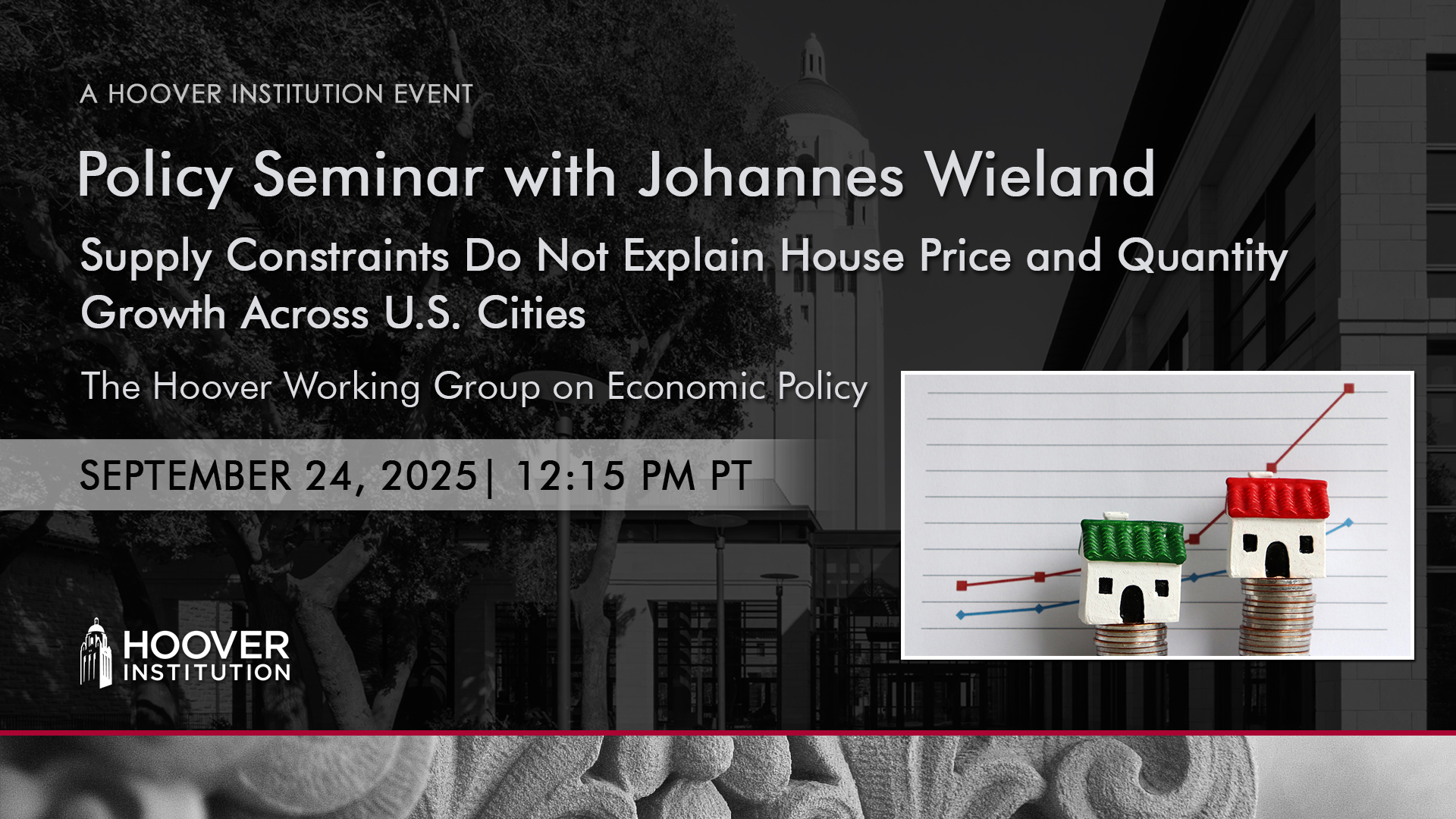“Supply Constraints Do Not Explain House Price and Quantity Growth Across U.S. Cities”
By Johannes Wieland, Senior Research Advisor at the Federal Reserve Bank of San Francisco and Professor of Economics and Endowed Chair in Macroeconomics and Public Finance at the University of California, San Diego, with Schuyler Louie (UC Irvine) and John Mondragon (FRB San Francisco).
SUMMARY
The standard view of housing markets holds that differences in the flexibility of local housing supply—shaped by factors like geography and regulation—explain differences in how house price and quantity growth respond to rising demand across U.S. cities. However, from 2000 to 2020, we find that higher income growth predicts the same growth in house prices, housing quantity, and population regardless of a city’s estimated housing supply elasticity. We find the same results when we examine rents, expand the sample to 1980 to 2020, use different elasticity measures, use per capita income or population growth instead of total income growth, and when exploiting a variety of plausibly exogenous variation in local housing demand. Using a general demand-and-supply framework, we show that these results imply that estimated housing supply constraints are unimportant in explaining differences in rising house prices among U.S. cities. Our conclusions challenge the prevailing view of local housing and labor markets and suggest that relaxing regulatory housing supply constraints may not materially affect housing affordability.
To read the slides, click here
To read the paper, click here
WATCH THE SEMINAR
Topic: Supply Constraints Do Not Explain House Price and Quantity Growth Across U.S. Cities
Start Time: September 24, 2025, 12:15 PM PT
>> Speaker 1: Welcome to Johannes to start out our fall WG. Wonderful.
>> Johannes Wieland: Thank you so much. Great pleasure to be here. Thank you all for coming. And let me start with this joint work with Scaladoo at Irvine, John Mondragon, who's here at the San Francisco Fed. And very importantly, these are our views and not those of the Federal Reserve System or the Federal Reserve bank of San Francisco.
So what's this paper about? There's a widespread view that we're currently experiencing a housing affordability crisis. So one way to look at this is this graph is plotting house prices nationally for the U.S. and medium household income. They're both indexed to 100 in 1975. And what you can see is that the growth of house prices outpaced that of medium household income.
And what common diagnostic for why we're seeing this divergence of house prices and incomes is that we're not building enough housing. Particularly we're not building enough housing in cities like San Francisco, like LA, like New York, where demand for housing has increased a lot. So this view, which is sort of exemplified by the YIMBY movement, the sort of recent push behind the abundance agenda, she says that these cities, like LA, like San Francisco, like New York, they have very steep supply curves.
They're very inelastic supply. So instead of demand supply diagram, they would look like the green line over here. So we have quantities on the X axis, we have prices, the Y axis. And cities like San Francisco, their supply curve would be very steep. So as demand increases in these cities for housing, that's gonna be primarily reflected in prices and not so much in quantities.
And that contrasts with cities in the Sun Belt, almost specifically in Texas, where zoning tends to be sort of much more permissive and where that same increase in demand would give you large increases in quantities and smaller increases in prices. Now, that steeper supply curve in these Atlantic cities, that could be regulation, it could be geographic concerns, could be a combination of either of them.
Either way, the view that's exemplified by the YIMBY movement. Again, the balance agenda is that inelastic supply here is a major impediment to housing affordability, that differences in housing supply are important in explaining house price growth and quantity growth for cities. So throughout this talk, I'm going to think of a housing supply curve like I've put up here, where the stock of housing or the growth in the stock of housing is a linear function of the price of housing.
And the psi here, that's measuring the supply elasticity. So low values of that PSI means a given change in prices means small increases in the housing stock. So that's an inelastic area like New York, like San Francisco. And then a big value for psi would be something like Houston and Austin, where given change in price translates into high allowed chains and quantities.
The policy prescription that follows from this view is that we need to relax these supply constraints, particularly in those those inelastic cities. Now what we're going to do in this paper is we will evaluate this view. We're going to look at the city level, more specifically metropolitan areas, and we're going to ask whether by sort of standard measures, cities that are measured to be less elastic in supply so that have smaller values for the side that are measured to have inelastic supply, whether the same change in income growth predicts a lot of change in house prices and a smaller change in housing quantities, just like you've seen on the previous graph, relative to cities that are measured to have more elastic supply.
And what we find is that from 2000 to 2020, differences in total income growth, per capita growth or population growth that predict exactly the same differences in house price growth, housing quantity growth, and population growth, regardless of the signs measured as a constraint. So regardless of whether they're measured to be more or less constrained.
We can some extent about data go back to 1980 as well, and there we find the same results as well. We're going to interpret these findings through the lens of standard demand supply, like the graph I've shown you earlier. And what that tells us is that our results quantify the role of supply constraints or the lack thereof, lack of both sides and supply constraints under any correlation between income growth and unobserved demand shocks.
So you don't have to worry that the measure of income growth is maybe not capturing all demand, that we also should think about the amenities. That's not a problem for analysis. Now that same framework also tells us that if we have shocks to housing supply that we do not measure, they can make these cities that have very different supply actually look more similar.
So that could create a bias. What we're gonna show you is that that framework tells us that can only happen under very specific conditions that are also at odds with this view that differences in how the supply are important, which is what we're gonna call the status.
>> Speaker 1: Kinda one on one of this.
>> Johannes Wieland: Yeah.
>> Speaker 1: So there's a demand shift. Are you saying that the supply is not really that the supply elasticity measures are wrong because you know, the supply curve is what it is so if there's a demand kit price got to go up. So how could this not be true?
Are you saying the supply elasticity really is the same everywhere? Or are you saying the demand shift isn't really a demand shift?
>> Johannes Wieland: So the, so we're not going to take an explicit stance on this but there's various ways you can interpret this and we have some preferences of which one we think is more plausible.
So one explanation is that the underlying suppliers are not actually any different. That would be consistent with us. And so these measures to extent they show some differences would be this measurement. It can also be the case that there are differences in supply since it is not captured by the standard measures we use.
And that's also again, we're going to sort of try to look at a broad range of measures that are constructed in different ways to handle that. But in principle that's also possible that there are underlying differences, they're just not captured by the standard measures we use.
>> Speaker 1: Or income growth might not be the measure of what groups have-
>> Johannes Wieland: Yeah, that's right, so the extended income group is. We'll talk a lot about that in the framework. But again I think the emphasis there is that if these are different, you just don't see it in the data. That also tells you something about how important these underlying differences of biases actually are.
And so that's the point we're gonna make.
>> Speaker 3: And I just wanted to interject, cuz I should have done that at the introduction. So Johannes is happy to take questions all through his talk. No, no, no, no. Which was great. So this was the perfect time for me to mention that.
Yes, so, so you don't have to keep your questions for the end.
>> Johannes Wieland: If you don't like this idea of this, the income Gov measures. We're going to use some standard measures from the literature that are instruments for housing demand or shocks to housing demand. We find the same results there.
>> Speaker 1: So if we all, we all have a house and we all get. And Stanford gives us all a raise, not clear that house prices go up. You need people wanting to move in, but if people want to move in. Move in, then you don't see the. Can't move in because there's no houses.
You don't see the income.
>> Johannes Wieland: I mean, the income is something I would see in your case, right? Because I would, I would measure income.
>> Speaker 1: You measure the income, but there's no effect on housing demand. We all get the house. I mean, maybe we will all.
>> Johannes Wieland: Well, yeah, so if there, I mean, in this case, again, like, I, I'm not quite sure exactly what model you have in mind here, but as I understand it, you're saying like, well, the quantity of housing around Stanford is fixed and so we're all just going to build up the price, right?
>> Speaker 1: Well, I'm not sure we are. I mean, we want a house.
>> Johannes Wieland: Yeah, I mean maybe, maybe in this case. But again, so the key is here we're gonna look at that. The unit of analysis that we're gonna look at is going to be the city, right?
And so in city and that's going to be important. We're not going to have anything to say what happens within the city. So about the neighborhood level, where I think it's very clear that some neighborhoods, and they essentially mostly build up. And there the results, I think, Steph, I'm happy to talk a little bit about this data, but there I think the Excels would look likely very different to what we're finding across cities.
So the paper is very specific in saying three subtype states matter across cities. We will not have anything to say here what happens within cities. But some of the measures I think directly speak to that and maybe I'll touch on that again once we get to exactly those.
In principle there's a lot of substitution that you can have within the city in terms of like where prices move, where quantities move. And we're thinking about what's the city level supply curve and do the city level supply curves look different? Not so much on the neighborhood level where I think there's much, much more evidence that those supply elasticities actually do.
>> Speaker 4: I would just add, I think you're asking like, should we expect there to be a margin for housing demand? As long as everyone has a house, I think it's very clear there's lots of evidence. And basically most models that Monica and Martin would write down would have a quality margin, right?
You buy a bigger house, you move to a nicer neighborhood, something like that. There's some people didn't get the raise and so there's gonna be some resorting across location and stuff like that. But basically it's an empirical question. I think you'll see that income growth is very strongly correlated with house price growth and quantity growth.
>> Johannes Wieland: So the punchline is it doesn't look like the supply constraints matter in the way we expect. It doesn't look like they map into differences in hazard supply elasticities like the standard view would suggest. And so, that's just sort of fixing signs of affordability, but sort of trying to relax in these constraints, might not be as effective as this VM size.
Okay, so let me start touching a little bit on so what we're speaking to. I've called this the standard view that there's these different suppliers out there and they're very important to think about housing affordability across cities. I mean, that's sort of exemplified by the first sort of two major set of papers here that think about the housing market specifically and then about broad implications.
But I also want to highlight there is also work out there that's in line with what we find. So finds much more limited roles for these supply constraints and takes in their across cities. And, and so we're, our work is sort of in line with that.
>> Speaker 1: I object to affordability.
>> Speaker 4: Yeah.
>> Speaker 1: Because someone's buying these houses.
>> Speaker 4: Yeah.
>> Speaker 1: If the prices were too high, people wouldn't buy them. They're affordable for someone.
>> Speaker 4: Yeah.
>> Johannes Wieland: All right, so I think there is exactly what housing affordability means, I guess, is in the eye of the beholder. And we're not going to take a strong sense of that.
This paper is going to be about trying to figure out whether these elasticities are going to be different across cities. That's what we're going to measure. And then-
>> Speaker 1: Ferrari affordability is a real crisis.
>> Speaker 4: Yeah, I believe that.
>> Johannes Wieland: Okay,, I'm gonna start with the framework. And again, I think, why is that model here?
Why don't we just jump straight into the data? John kind of already touched on this. At some level, what we're looking at here is going to be correlations. Right. We're going to look at correlations of longer changes in housing prices, housing quantities, how they correlate with income. How can those correlations tell us anything about the importance of supply constraint?
Do we need some causal relationships there? And we're gonna argue, again, based on the framework that actually these correlations are gonna be very informative and helpful for answering these questions. It's going to be standard demand Supply we're going to think about the local housing market. We will assume that demand reflects total income.
I think when you see the data you'll find that that's not going to be a strong assumption at all. And we're gonna take a very sort of non-causal approach here that the total income growth here can have any correlations with demand and supply chains. And even so, we're gonna argue that the co-movement of housing price and quantities, and this is very important, you need to look both at prices and quantities together.
If you wanna think about what's the supply curve, you need to look at both, that co-movement of the house price and quantities. Income growth is actually gonna be very informative about how important these differences and stops of supply RTR. Now, the easiest way to see this is by starting with this.
What is the main assumption we're going to make? We're gonna assume there is one supply curve for housing and it's in terms of the, sorry, this is the button, in terms of the housing stock. The growth in the housing stock end is gonna be a linear function of the price and size is gonnabe that supply elasticity.
And we want to understand when can we measure that difference of the supply across cities and is that going to be important for think about house prices and quantities across cities. Here we're going to allow for some supply shocks and again we're going to allow for any correlation of that supply shocks with income growth.
This is a supply curve in terms of the stock. We think that's appropriate in our context. We're gonna look at very long at differences of 20 years. So stocks are more appropriate than flows. We look for longer horizons when adjustment costs will have played out. Now, we're gonna imagine here there's gonna be two types of cities.
This is going to make our exposition simple. There's gonna be the cities where supply is super elastic. So that's gonna be your cities in Texas, your Austin, your Houston. And then we're gonna have a low elasticity cities like San Diego and San Francisco. And we're asking when can we recover those different elasticities?
And the simplest way to see sort of what the issues are is just to think about an instrumental variables regression where we're gonna instrument the price with income growth, that's gonna be my variable Y. And use that instrument in the second stage where we request the units of housing or growth units of housing on that instrument of price.
We're not making a cost of fame here, we're not saying income growth is exogenous. But for the purpose of thinking like is it that we're actually measuring when we look at this co-movement of prices and quantities with income growth, this is gonna be, I think, the most informative regression.
>> Speaker 4: How do we think about population here? It's exogenous, endogenous?
>> Johannes Wieland: We're not taking any stance on that, so yeah.
>> Speaker 4: It seems it might be important.
>> Johannes Wieland: Yeah, so at this point we haven't put any restrictions on that as well but let me go for the next one then you can kind of see like when when might the population margin actually matter this.
>> Speaker 1: Is total income, so what you're saying is that more income and more people with the same income will have the same effect.
>> Johannes Wieland: Yeah, so the total income growth, yeah, it's gonna be the sum of per capita income growth and-
>> Speaker 4: Why is total income.
>> Speaker 3: You're assuming that the elasticity of price with respect to To population is the same as with respect to income per person.
>> Johannes Wieland: So at this point, we're not putting any structure on that at all, right? The only structure I put on the model right now isn't that this is one supply, right? So it doesn't, it doesn't impose anything. I'm just telling you, like if you then run this regression, what is it that you're actually picking up in the data, right?
In that sense, exactly how a population plays in here. I don't have to take any stance at all.
>> Speaker 1: Yeah, I guess it's that income, the assumption is that total income is uncorrelated with the other things that move housing supply.
>> Johannes Wieland: Not yet, right? And so you actually see this.
Exactly the next formula. Yeah. We're using an instrument, but we're not saying it's exhaustionist, right? And so that's-
>> Speaker 1: We are uncarrelated with the error.
>> Johannes Wieland: Well, that's why we're running an IV regression. But we're not claiming the instrument we use is actually exogenous in the IV regression.
So we're really just running an iv, but we're not. But not making any exaggerated stuff. You'll see it in the next formula I put up there. Wait a second.
>> Speaker 1: Before we get to the next formula, what is housing square feet? Is it quality adjusted square feet?
>> Johannes Wieland: So in the data we're going to show we have units.
That's the thing we can measure the best. And I'm going to show you some. So that's the extensive margin and the intensive margin we have. So rooms per person. So then you have a notion of the housing size. That's what we can do on the, on the next one.
>> Speaker 1: So in Stanford we all get a raise, we remodel our kitchens. So that would be out of here, okay.
>> Johannes Wieland: Yeah, so there's going to be. We'll talk about that later on. So there's no notion of quality here at this point, right? So the only notion we're going to have is units and sizes.
And to the extent we're going to have the model I've written down. So when we think about the housing supply, this is a house, right? So there's no notion of like it's a better house, it's a worse house.
>> Speaker 1: Look at the prices and the affordability. I mean, the new houses are way, way better than the old houses.
Tour my neighborhood in Palo Alto. They'll show you.
>> Johannes Wieland: Yeah, no, no. And there's no disagreement again, like so on the, on the size. That's something we can do. Like on the quality I think is a much bigger question and we think that actually is somewhat relevant in some of the figures level I will show you.
But I think I would say like in terms of the broader debate here when we're thinking about like the differences in housing supply and how that's causing the affordability crisis, the notion is that we're not building enough high quality units, right? We're not building enough houses period. And that's sort of what we're trying to get at.
I do think these qualities are very important, and they're very interesting, and it's something we are working on, and we'll see. I think some of that in the data, but it's not really the main focus of this paper which is follow.
>> Speaker 4: We do think that this basic issue of ignoring quality is actually a big reason why the mainstream view has kind of gone astray empirically why we can find what we do.
And there's 25 years of literature that argues very different things.
>> Speaker 1: I guess San Francisco, the, the techies move in to a completely devastated neighborhood. The prices go up but of course they, they turn the same number of units which you absolutely not to change into, you know, wonderful things.
So that's.
>> Johannes Wieland: That's right. And I would say like in principle, right? So the, the kind of data we're using in principle these housing price indices that we're using for other analysis, they should, they should measure constant quality housing. Right. Now, in practice that's. It's almost impossible to get that right.
And we think that's actually again like we'll get to. I'll get back to an example of this question. When we, when we talk about some of the patterns we see in the data. But we think this quality is actually so first order now when it comes.
>> Speaker 4: To Palo Alto, Stanford, the majority of the value of a house is really the land.
And now to assume that the supply of land is zero elasticity is so whereas I know in the Chicago area there's lots of land to convert a cornfield to apartments. So the fact that you're this value, I think it also includes the value of the land. But your story doesn't really.
>> Johannes Wieland: Yeah. So it's got a little bit loud. Yeah.
>> Speaker 4: Was construction.
>> Speaker 1: I think that's wrong cuz land in Palo Alto is a license for floor area. You can't take the same land and build a 100 storey apartment building, not allowed. So the constraint is really the regulatory constraint on what you multiply land by to get floor area.
And that can change.
>> Johannes Wieland: I mean, in this literature, there's a number of discussions about what makes these supply different across cities, right? And so one, one view is like, you know, if you have lots of land at the edge of the city, well, then your supply can be super elastic.
Right. If you have very tight regulatory constraint, well, you know, then the houses don't get any bigger, you're not going to add any more units, you're not going to build any apartments. There's also a reason for why a supply might be inelastic. So that's all going to be kind of, I would say that's within this framework.
We're not taking a stance of what drives these difference in elasticity. We're trying to measure these differences, but across cities. All right, so back to John's point, I'm assuming this income is exhaust in some sense. No, because the only thing we've assumed is this housing supply equation. And that alone will then tell you what you're picking up in this IV estimate.
Theta here is going to be the sum of the underlying supply elasticities in this type of city. So it could be at a higher low, depending which group of cities you're looking at, plus the bias term. And the bias is just coming from the covariance of income growth with the supply shocks divided by the covariance of house price growth with income growth.
And so what you learn from that already is if the only sort of shocks you're going to see in the city are demand shocks, and some of them might be correlated income, some of them might not. But if all we're going to be experiencing are demand shocks, if we're moving along the supply curve, that's really not a problem for us at all because we're just still moving along the supply curve.
And so any of that variation will help us identify these differences in supply. Obviously, if you live in this beautiful world where supply shocks are also not correlated with income growth, then it's even better for us because then there can be supply shocks around, we still can identify the difference in us.
To start more realistically, you're going to have some correlation of supply shocks of income growth. But so long as that's the same across the groups of cities, the elastic and inelastic cities, the differences in our estimates are still going to be informative about how different the supply estates are.
So when could we run into trouble? When could we, you know, we have these elastic and inelastic cities? When will our estimates go astray and tell us they actually look the same. But what you need is that supply shocks are more correlated with income growth in the inelastic areas.
So essentially, that bias term here is bigger in inelastic terms, or vice versa, smaller in the elastic areas. So you can think about what could be the story here. How would this have to work? Just to be clear here, there's also denominator here, but empirically, that's the same in the groups of cities.
So that's something we can observe in the data. So it's really a question about what this numerator is. What's the story you would have to think of? Start with the inelastic cities. The supply shock has to be more correlated with income growth, which is to say, as income growth goes up, if you look at these high income growth cities like San Francisco, San Diego, you need, on average, more positive supply shocks, more building in these cities that makes the cities look more elastic.
Conversely, you can look at the elastic areas. What would you need there? The correlation has to go the other way. They are the high income growth cities in elastic areas. They have to suffer from negative supply shocks that will increase their price, reduce their quantities and make them look less elastic.
And so in this world, these supply shocks that have mask the underlying differences in elasticities.
>> Speaker 3: Johannes.
>> Johannes Wieland: Yeah.
>> Speaker 3: Can I ask?
>> Johannes Wieland: Yeah.
>> Speaker 3: How do you think about interventions by local governments to try to improve housing supply? So I'm thinking about San Diego where the crazy city council took the state thing and just went crazy allowing ADUs.
Now they come back. Would that be a shift in the supply curve or because ultimately it's affected by prices. Is that the slope of the supply curve?
>> Johannes Wieland: Yeah, so I think exactly how this maps into demand and supply is actually very tricky once you look at changing zoning.
So there's an extensive empirical literature on this. Freemark has a survey article on that. And I wouldn't say the results super consistent across what people find. I think generally what you see is that sort of increases in construction. But at the same time there's also, I think, that the evidence on prices is mixed.
If anything you see actually higher prices. So it's just sort of some more gentrification happening. So if you look at this sort of zoning reform, it's pretty tricky to think of that just as moving supply and isolation. There's probably demand happening as well. I would say Matt Kant's paper on the coastal zone kinda also goes in that direction.
They find evidence of gentrification as a result of that regulation. So I don't think that maps so cleanly in what we're talking about.
>> Speaker 1: Confusing the econometric framework.
>> Johannes Wieland: Yeah.
>> Speaker 1: Is sigma the same as W or is that something else?
>> Johannes Wieland: In this case, and since I've assumed the, there we go.
This is the supply curve I have assumed. So then it is the same as sigma is the same as W and then the kappa would be zero.
>> Speaker 4: And then. So there's this other variable in here which is you have an indicator for high or low supply elasticity, but that's not the supply elasticity because you're trying to measure the supply elasticity.
So there's some assumption about how this indicator for higher low elasticity is correlated with something or other.
>> Johannes Wieland: So the assumptions, I mean in this framework what we're assuming is that there's two groups of cities. Right, so underlying is they have some assets that have a high supply and some have a low.
We're not taking a sense of how different they actually are at the end of the day. But we're able to separate these cities based on some versions we have. And the question is, like, if we can do that so we can separate them and we run these regressions, are we actually going to uncover there's a difference between.
>> Speaker 1: It's not this.
>> Johannes Wieland: No.
>> Speaker 1: It's between this across two-
>> Speaker 4: So this is essentially, this is the regression of within each group we can estimate this theta. And so then the question is like, do these differences in thetas tell us something about the underlying supply? And the claim we're making is another first of three conditions we do.
And then if we don't, well, what do we learn from that?
>> Johannes Wieland: Well, what you need is that in these inelastic cities, the income growth is systematic, or the effect of income growth on higher house prices is systematically offset by supply shocks in a way that makes the difference in supply is not relevant.
When you look at the correlations of the covariances of income growth, of house price growth and housing quantity growth with income growth. So again, in that case, when you look at how house price growth and housing quantity growth could move with income growth, it will look the same because these supply shocks will mass the underlying differences in elasticity.
But I was just saying these underlying differences in elasticity are ultimately not gonna be important for explaining that difference. And then later on, we're going to show you what happens when you try to get rid of this term completely, the bias term, by using instruments. And you'll see the same results there as well.
But let me sort of just. I think the clearest way to get at this is then show you the pictures again. It's very important to look at both prices and quantities as you compare these groups of cities, our elastic cities over here and elastic cities over there. Because what you could see is that there's a correlated demand shock, G1H.
The way I've drawn it only occurs in the elastic cities. So now when you compare price growth in the elastic elastic cities with income growth, it looks the same. But when you look at house price, the housing quantity growth income group, that will look very different. Which is to say, if you look at both these variables, the matchup is another problem.
You're just moving along the supply curves anyway.
>> Speaker 1: So you're not arguing that there aren't cities that are less elastic than other cities. The question is just quantitatively, the elasticity isn't that different.
>> Johannes Wieland: Yeah. So I mean, at the End of the day, what we're going to estimate is that actually look very similar when you group them based on standard measures.
I think that's true economically and statistically. And so, I think there's a broader question in what did these measures then ultimately capture. But I think we'll leave that for the end.
>> Speaker 4: Does this methodology depend on classifying the cities into high and low in the first instance?
>> Johannes Wieland: Yeah.
So I mean what we do assume, and again that's I think reasonable based on where the literature is, is that these measures of supply constraints are telling us something about what the supply elasticities are. And to some extent they are actually directions of supply elasticities. I'd estimate on different samples or different units of aggregation.
>> Speaker 4: I didn't understand that. Suppose you have 100 US cities and in reality 50 of them have high elasticity, quite high, others are quite low. And then you adopt your methodology and you say well we think based on characteristics that some different 50 are high and we measure whether they're different than the other 50.
But you're just, you know, your 50 is the wrong classification, you're averaging across two groups and you don't find any difference. Then in the first instance your classification scheme becomes very important. I'm just trying to understand is that the case? Is it important that you-
>> Johannes Wieland: No, the classification scheme definitely is important.
And so the way we try to handle this is we look at a range of different measures that people have in the literature said these are ways to measure differences in supply elasticity and we're going to use those to classify cities. Now, it is possible that those are all measured of error, right?
And so that might be a reason why we don't find any differences. But then there would be a broader point which is, if things that we classify on are gonna be things like regulation indices. And if these regulation indices then ultimately are not important for explaining the policies is that I sort of brought a message then here like, well, the walls regulations that actually matter, at least that's measured there.
>> Speaker 4: Put another point on it. You can show that the prior literature is wrong, but that doesn't necessarily rule out that there is a high versus low elasticity classification that's out there somewhere.
>> Johannes Wieland: Yeah, that is possible. Again, I think we're trying to preempt that as best we can by using sort of broad based different ways of doing that measurement, that classification.
Let me make the final point here in the graph which is this idea of, well, obviously once there's supply shocks we don't measure the supply curve correctly. And so, the example here is one way every city gets this increase in income growth. But inelastic cities, there's a correlated supply shot that shifts out supply and ultimately it makes these cities look actually very similar.
They have the same house price growth, they have the same income growth on average. So here we wouldn't measure any difference in the supply of sd. But essentially it's because the cities are expanding the same house price growth, the same quantity growth, because there's these systematic correlated shocks here that are masking that difference, if those exist.
It also means in this way that these differences in supply are not important here for expanding house prices growth and housing quantity growth across cities. So that's why we think even the plain vanilla or less HB results here are actually very informative for thinking about how important these supply constraints or these differences in supplies actually are.
>> Speaker 1: I remember econ 101 problem of just understanding the difference for housing between a shift in the curve and a movement along this line. What kinda things cause a shift in the curve versus a movement along the curve?
>> Speaker 4: Yeah.
>> Johannes Wieland: So, are you thinking about the demand curve or the supply curve?
The supply curve?-
>> Speaker 1: The demand curve better?
>> Johannes Wieland: Yeah. I mean the, the, I mean shifts in the curve would be things like, you know, construction productivity, like shocks to construction productivity would be one way to do it.
>> Speaker 1: Any of those?
>> Johannes Wieland: Yeah.
>> Speaker 4: Cost of construction for wages would probably be the main one I would think of?
>> Johannes Wieland: Regulation changes.
>> Speaker 4: What would protect the regulation changes, are in response to prices
>> Johannes Wieland: I mean, any movement along the curve, I mean that would be like a shift in demand, right? So then that's what we're trying to get at.
>> Speaker 5: A separate question. I know within city variation is ignored here, but is there any way that we can even logically just say why like high elasticity neighborhoods aren't taking up all the brunt of this?
And it's still the same mechanism that the high elasticity neighborhoods can build. And they're kind of making up this effect that we're observing. And you still have the same classical doctrine that it's the regulations and low elasticity neighborhoods that are slowing it down.
>> Johannes Wieland: Yeah. So I would say again, like we're explicitly staying away from the neighborhoods here.
And I think that's, I say the broader debate here, when you think about the Yimby abundance movements, they're about positive comparisons. We're speaking to that. But I think the result that's sort of most informative, I think about that difference is Bob Snow's JP article where he essentially, if you look across the narrow neighborhoods, what you see is a beautiful negative correlation of house price growth and quantity growth.
So, the parts of the city where quantities grow the most, that's where prices grow the least. And then vice versa. Where you have, where quantities go, these prices go the most. The moment you aggregate that to the metro area, all that goes away. And so, there's no correlation at all between house price growth and quantity growth.
And that's, I think, very informative that like when we're starting to look at the city level and we're starting to compare across cities, the kind of forces we're looking at are going to be very different to what we're doing with the neighborhood analysis. So that's why again, we want to be very clear here.
We're not saying these regulations don't matter for the makeup of the city. I think most likely they very much do. This is really a question about what do these supply curves look at the city level and how that.
>> Speaker 1: So how are cities different than neighborhoods? The obvious one is people move between neighborhoods and they're much less likely to move between cities.
So the story of people moving into the city and driving up the price really isn't that relevant compared to the story of we all spend 30% of our income on houses and we get more income.
>> Johannes Wieland: Yeah, I mean, I think that there's several margins you can think about substitution.
So you can think about substitute people moving in the city, like where are they located? You can think about, think about like regulations that say do not permit certain types of building in certain parts of the area, but maybe you can build somewhere else.
>> Speaker 1: Why are cities different than neighborhoods?
The only thing I can think of is that people move between neighborhoods much more than they move between cities. Why would you get the opposite result comparing cities than you do in comparing neighborhoods within a city?
>> Johannes Wieland: So, I mean, I think is you can have, you can have prices growing in the center and you have quantities growing at the, at the edge of the city, Right.
And so, when you look at the city itself, what you're measuring is your price is moving in large set of quantities. But once you're looking at the neighborhood, then the, that correlation would look very different, right?
>> Speaker 1: Because people substitute between suburb and the center in a way they don't substitute between San Francisco and Fresno.
>> Johannes Wieland: Yeah.
>> Speaker 3: Yeah, so does your city unit overlap local governments?
>> Johannes Wieland: Yeah. So, I mean, it's the metro area, right? So, I mean exactly what the metro, how that matters in local government varies across the country. So in the western United States the counties are bigger. Eastern United States, you tend to have more different kinds of regulation within the metro area than the western.
>> Speaker 3: I mean these differences between neighborhood versus city might be informative about how much of it is from the local city government. Or it could be it's just heterogeneous treatment effects that the local city government protects the well to do neighborhoods from having extra housing put in there and but then allows lots of elasticity in the outlying areas kind of thing.
>> Johannes Wieland: Again we'll leave it there and we're happy to talk more about that distinction, but let's move on. So, this is then what we're going to do. So we're going to look at the co movement of housing growth. That's age and price growth with income growth and we'll look at how that's different.
These are the beta fees and gamma fees for cities that we measure to be less constrained. What we expect is that we see less house price growth in the more elastic areas than in the inelastic area. So, this beta would be negative and the gamma fee would be positive.
So more quantity growth. Alternatively, we can run the DIV there. We would expect a higher measure elasticity and elasticity in elastic places. If these supply constraints end up being important for explaining house prices growth and housing quantity growth across cities. Again, the point here is that even the correlations are actually going to be informative for understanding how important these supply messages are.
And if you do find that, if you do find that it's these unobserved supply shocks that somehow make these cities look similar. Even though underlying are these different elasticities, it would still mean that this difference in supply constraints does not explain difference in house prices and quantity go up across cities.
But then if you wanted these city instruments, we're going to show you those. Anyway, let me walk you through the data. We're going to do everything here at the city level, so we extend discussion about that. As well as Saeeds, we have four different measures of housing supply system.
Again, the goal here is to sort of use various different ways of getting this idea that you supply, these are different. Across cities. So we're gonna use Saiz seminar work, Bombsnow, and Hajj. Is that constructed at the neighborhood level and then aggregated up to the city level. We have a purely regulatory index, the one regulatory index from Gyourko, Saiz, and Summers and then the fourth version is the land share and the home values from Davis, Larson, Oliner.
And we're gonna try sort of look at a broad range of different ways of measuring different suppliers. Everything else here in the terms of data is gonna be pretty standard. You have about 320 MSAs that we have this data for which we have house prices, housing values, rents, income growth, quantities, population and then intensive measure of housing size.
The first thing I want to show you is and why it's very important to look at both quantities and prices. Prices alone are not going to tell you the story. So I'm gonna look at the metro areas of which I have the Saiz elasticity. There's about 260 of those.
I'm going to bin those based on the size elasticity. So this point over here, this will have about 13 MSAs with the lowest value for the Saiz elasticity split point over here we'll have at the 13 points with the highest elasticity. You can see this very clear negative correlation.
The cities that look most constrained by this measure have the highest house price growth. The cities that are least constrained have the lowest house price growth. But this is a story about the supply being different that's driving the difference in house prices. What you should see is that you should see the opposite pattern for quantities.
You should see that quantities grow the least and the less elastic places and grow the most in the most elastic places, it is just a story about that.
>> Speaker 1: Huge assumption about demand here.
>> Johannes Wieland: Yeah, of course.
>> Speaker 1: Nothing, the supply curve is inelastic, that means the prices are going down even faster in inelastic places where people are leaving.
>> Johannes Wieland: Yeah, and you're absolutely right. So demand is very important because once you-
>> Speaker 1: Demand, well, I guess populations increase.
>> Johannes Wieland: That's right, but essentially what that tells you is that the supply, well, okay, let me show you the quantities, right. So the quantities places also have higher quantity go for the higher place.
That tells you that the math matters here, right? On average, low SDG cities also have a higher, greater increase in demand the lower elasticity places. So the correlation of these elasticity prices alone is not measuring the contribution of the supply elasticity. But you need to condition on the bat.
>> Speaker 1: Is that a vision? What does this supply elasticity measure mean?
>> Johannes Wieland: Well-
>> Speaker 1: I mean, is it regulatory barriers?
>> Johannes Wieland: Yeah.
>> Speaker 1: Land, is it?
>> Johannes Wieland: So the Saiz elasticity is specifically constructed to capture the difference in so geographic constraints across cities, right? So that's that construction.
Again, so the exact measures differ on exactly how much the regulatory index was obviously be more about regulation bumps down high kind of loads them both.
>> Speaker 1: And geographic.
>> Johannes Wieland: This is geographic.
>> Speaker 4: It does matter in the sense that the Saiz elasticity is a semi structure. It is not just like take the land use in survey like the Saiz elasticity is a semi structural estimate that comes out of progressions of house prices on supply and supply and land use regulation.
I guess you're not for regressing to the same.
>> Johannes Wieland: Yeah, so let me postpone that to the next graph because I think that's gonna be more along the lines of getting at actually this question, so wants to estimate the supply SSG, right? So you need some shift in demand to do that, but right now this is not doing this.
So these figures are not gonna be comparable to exactly what Saiz is doing. But as the final point to drive the final graph to drive the point home, you look at the correlation between quantity growth and house price growth. Again, that's positive, right? Tells you demand matters, the cities to the highest house price growth have the highest quantity growth as well.
It's not just a story, so that brings us to the regressions we do wanna run which is trying to get at these differences in slopes, right? So what we're going to look at is as income goes up in the city, do we see that difference in slopes across cities that are us more elastic versus versus less elastic do we see more house price growth in elastic cities, less house price growth in elastic cities.
So here in my 260 metro areas and I'm going to group them into either more constrained or less constrained. So more constraint is going to be the bottom half of the size elasticities. So the lower elasticities and the less constraint is going to be the top half and I'm going to bin them by their real total income growth in the city and then calculate average house by scope within the bin.
So the red lines here they are less constrained, the blue line are gonna be the more constrained. The prediction here from what we call the standard view is that as income growth goes up you would expect to see a larger increase in house price growth inelastic cities. And the last which is to say that this blue regression line that should be steeper than the red regression line so that the same income growth gives you more house price growth in elastic cities.
But in the data, the slopes are essentially the same. They're parallel to one another. That same increase in income growth is that same increase in house price growth, regardless of whether these cities are measured to be more elastic or less elastic, that is just one. Let me say one more thing which is what you do see is you see a difference in the average house price scope across these cities.
So there is these cities that are more constrained, they do have higher house price scope on average, regardless of whether they grow a lot or not, whether the income growth is high or not. And I get back to how you can think about that and how you relate that to this view about difference in supply elasticities.
But the basic prediction from the standard view is that these slopes should be different. And that's not something we see in the data.
>> Speaker 1: Assuming that elasticity and income growth are uncorrelated with each other. I don't know why, but my impression is that the places where income growth has been really high are also the places that have horrible elasticity problems.
So those are correlated right off the bat.
>> Johannes Wieland: So correlation of the elasticity of income growth is actually economically not a problem at all. The only problem you have is correlations of supply shocks. So in the elastic base, on average can have lower income growth or high income growth, that's causes a metric problem at all for us, right?
Because the only way we get the slope of the supply curve wrong at some level, what you're saying is like, well, you know, I move along the supply curve, but like in elastic places, I'm, you know, I'm. My demand is higher and so I move up kind of over there.
And then in the less elastic places income growth is average lower. So I move just in a different part of the graph, but I'm still moving along the supply curve. So that correlation is not, it's not an issue.
>> Speaker 1: My impression is people want to move to San Francisco and San Francisco passes a whole lot of ordinance stopping people from building houses.
So the facts are not separate from each other. That we have very inelastic supply and that there's a big income growth here.
>> Speaker 4: I agree. Another example of that is high wealth. Neighborhoods are gonna protect their land from development more effectively. Like Palo Alto, for example.
>> Speaker 1: Nobody bothers to pass the zoning code in Buffalo, New York.
No one wants to put any houses there.
>> Speaker 4: But again, what that suggests is that as demand, as population goes up in SF prices go up faster.
>> Johannes Wieland: Yeah. Maybe at this view you would expect to see that maybe this in the less elastic place, as income growth goes up, you would actually see some more steepening in that curve, right?
Again, that's not what we see in the data. So at least at the city, and again, like the neighborhood level, I will not take a stand on this. But I think what you're describing is reasonable. But at a city level at least, that paradigm does not seem to be there.
So now we're going to do this exercise. So we did exoplore. This is for Baum-Snow and Han. Same idea. We're looking for differences in slopes. Now the only difference we do is we classify them different. So the group of more constrained and less constrained is going to be slightly different because these measures are not exactly the same.
But the basic picture you get from these graphs is the same, which is as income goes up, house prices go by the same amount regardless of whether they're more or less constrained. And here actually the difference in levels is not very big relative to the last one. So we can keep going with this.
This is the regulatory index here maybe you see a little bit. I'll talk more about that once I show you the table. And then this is the land share value. And here it's just flat. The same slope.
>> Speaker 5: That's impressive.
>> Speaker 1: The standard way you look at houses with a heavy dose of Q theory because it takes a long time to build houses.
And you should have said this is long enough from that doesn't matter. But if you say San Francisco, there's a steady flow, a higher flow of people coming in. You steadily have to have a high investment rate. So you would steadily have a higher Q.
>> Johannes Wieland: Yeah, so-
>> Speaker 1: And vice versa, on. What Buffalo New York is Q less than 1. So cheap place to live.
>> Johannes Wieland: Yeah. So I mean, I totally, I totally agree on the point. When you are in the cities where population is declining, I think I guess I made the point very well.
I totally agree that. There are essentially what you're looking at is you're just waiting for the housing stock to depreciate. The housing stock is super inelastic, but it's not because of regulatory constraints. It's just the houses are there, nobody wants to live. You're just waiting for them to go away.
That's actually kind of most of what you see in the regulatory index. I'm not doing very well here in the clicker. The steepness in the blue line comes off from these log of cities that feature that like Detroit, where you're just kind of waiting for that supply to depreciate.
Once you exclude those then the stops again. So I'm going to later show you what happens when you go back to 1980 to 2000. We can go 1980 to 2020 so we have a 40 year difference. So that should attenuate these issues about Q theory.
>> Speaker 1: You're thinking of as a one time shift and then we adjust.
But if you think of it as there's just a constant flow of people into San Francisco then you would need constant investment in a constant q greater than 1.
>> Johannes Wieland: But I don't think that would. So everything we've. The longer the time horizons you're looking at, the smaller is going to be the contribution of the most recent arrival that has not been built into the stock yet.
So the longer you're going to take the long view, the less the flow piece, the last adjustment is going to matter rather than the stock piece. And so again, like the long wait, the window we're going to find the same thing. So I don't think that's really what's driving this.
But I would have to think more about.
>> Speaker 1: There wasn't a one time shock. House prices exploded as they're supposed to do, and we slowly build the prices come back again. What happened was prices just keep growing year over year.
>> Johannes Wieland: Yeah, but you see the same thing with quantities too, right?
So and then at some level you're measuring, it doesn't look like the supply curves essentially like look different whether you're growing sort of very quickly. I mean again, if anything, if these really quickly go cities they look like the stock of anything but somewhat flatter than the slightly less growing cities.
So this does not feel like it's a problem for us. But I'll have to work for that a bit more carefully before I give you a more definitive answer. John, if you had thoughts on that?
>> Speaker 4: I think it's hard to think of that model where you wouldn't get differential price responses if there's something about the production function of housing that makes it take longer to produce the housing in these particular environments.
So, so I think you know that dynamic makes a lot of sense to me that you talk about but I think it should still be apparent in how quickly prices respond to slow down the incoming flow of people because you don't have the space for them. That's my reaction.
>> Johannes Wieland: So there's the tip. I haven't really mentioned this, but income growth is a very powerful predictor of house prices. You can see that's how things line up around the progression line. So that it's not like we're just progressing noise and noise here. But what doesn't seem to matter is these measures of supply constraints.
So you could look at the interaction of income growth with what I see is less constrained. That's all small. That's all statistically not significant. That's the piece that doesn't seem to matter. It looks like we're not measuring differences in slopes.
>> Speaker 3: Less constrained is that intercept that you were showing.
>> Johannes Wieland: The interaction is the direction is the slope. Yeah. Interaction is the slope and then the intercept is the bottom row. Yeah, that's the data set.
>> Speaker 1: Are you assuming that all the less constrained are the same within group elasticity?
>> Johannes Wieland: So we have essentially estimating group average here, right?
And so the model I've showed you just has two types of cities. But we work with a case where, essentially you can have a continuum of different cities. You actually run the continuous interactions too. You'll find the same results there. But essentially the way you want to think about this is to extend these cities are different within cities where we're measuring an average between them and you can kind of work out like, you know, because we're using.
It's not like a simple average across them. It's, it's a little bit more complicated because it essentially weighs the estimates the individual cities by their housing supply as well. But we worked through the work throughout Monte Carlo of this, and these within group heterogeneity doesn't seem to matter.
We've done a continuous interaction. We've done quartiles. You find the same consistent picture there. It doesn't seem to matter in the data. It doesn't seem to matter in the Monte Carlo. So that's for us the most transparent way of showing.
>> Speaker 1: It's struggling because we all kind of know San Francisco, a small number of very wealthy people moved in and the house prices exploded.
Dallas, a large number of not very wealthy people moved in, but total income grew and they built a ton of houses. It still sticks with me. And I'm trying to figure out what's.
>> Johannes Wieland: Yeah. So another thing that I have here in the buttons, but I'm not quite sure how to press it is.
So the housing supply curve I put up again like this is like very standard from literature. You think about these different supply it doesn't really matter where the demand is coming from. It is moving along the supply curve. But what you see in the data is whether. So I've shown you things with total income growth.
So if you separate total income growth into per capita income growth and population growth and ask, well, how do those things look like? What you still see is for per capita income growth, it has the same effect on house prices. Regardless of whether measured to be more or less constrained, same for population, regardless of whether more or less constraint.
But what you find is that per capita angle has a much stronger effect on house prices, on population growth. Per capita angle growth has a much stronger effect on a much weaker effect on quantities and population growth. And so if you. I don't know the Dallas numbers specifically, but we did look at, for instance, the number of San Francisco, Houston, if you look at San Francisco, per capita income growth has been up about 2.2% per year.
And house price about the same. In Houston, per capita income growth has been up by about 0.8% per year. The house price is about the same. Once you start separating these two pieces, it actually looks like there's no puzzle here. So there's just a kind of different types of demand which puts us outside this framework.
But in terms of thinking about what's different about these cities, like I said, the nature of demand that these cities are experiencing is very different.
>> Speaker 1: Yeah. Assuming limited immigration and replacement fertility falls below 1 by 2100, if you don't ever build a house, the demand is going to crash.
Oil prices will crash, all the banks will crash. And unless robots can be generated to move in, your story is going to bear no relationship to the future story. So I just wanted to make that point. I have a. Is this open to. Can I ask, raise another general point, please?
Okay. Well, most of us are Stanford people. And being retired, I read everything that comes in over the transom. So the Monday message from the provost and president was one of Stanford's three priorities, is to be number one in the world in artificial intelligence. So I asked my friend Chatty if he would gather up all the supply literature and then take your paper and evaluate the strengths of your papers.
Very nice. And then evaluate all the constraint stuff. And then how does your story hold up? And so the Fed's rising income demand view is strong. The Fed referring to the paper, but not the full story. Some of its limitations underplay supply constraints. There's eight of them. Eight.
And then it goes on to tell three more stories. Now, I'm certainly not going to eat up the rest of the time telling you what these are. And then the conclusion is, well, it's really been helpful, but it would be a lot more helpful if you accommodated these eight constraints.
I'll leave this with you. But so I'm going to ask you, did you ask Chatty before you came in here to evaluate your paper? And if not, why not? Because I already did this for next week's paper. And it's astounding that if there's a draft circulating anywhere, it'll find it and it'll take every piece of literature ever written and it'll tell you the pros and cons and weaknesses.
And quite frankly, Chatty says, well, you know, I'd go back to the drawing board and I'd take into account these other things before I would present a paper like this. Now, I'll leave this with you, of course, but that's the story. So, you made some attempt to get at some of these, but Chatty isn't happy with it based on the review of all the supply literature.
>> Speaker 4: Yeah, I think that would be my response. Is the problem with ChatGPT. It's been trained on all this literature, which we think is deeply flawed.
>> Speaker 1: No, there's nothing wrong with anything in here. There's no mistakes.
>> Speaker 4: Right, but we think there are mistakes in those papers.
That is, there are mistakes in the frameworks and things that lead, say, elastic. To estimate elasticity that isn't actually elasticity.
>> Speaker 1: I know, but the point is that you hinted at some getting at one or two of these, but there's a whole body of commentary here that you don't get into.
And that raises the question as to whether or not your conclusion from a policy standpoint holds up or doesn't hold up. That's quite apart from all this other stuff here and whether or not when you want to address certain problems in the housing market, that is, you want to make more affordable housing, you want to produce more, whatever you want to do with the housing market, you haven't addressed these weaknesses in a way that lets your paper reach the conclusion you reached.
So all I'm saying is it seems to me that you could have itemized these very easily.
>> Speaker 3: They do. If you look on their website, they have a long faq and they also have two responses to the literature. And the question is whether. But we should let them have the final.
That's a really useful thing about beating something.
>> Speaker 1: So there may be FAQs, but the chat looks at the paper and it looks at the analysis of the paper and it looks at the strengths of the paper and the weaknesses of the paper. So they may try to answer some of this, okay?
But if you're going to take a paper like this and ultimately publish it or use it as a guide, then I would think you would want to use artificial intelligence to raise every conceivable question that might pop up. But, by the way, let me go further. The beauty of it is that it then takes you further.
So what it will do is. And I didn't do this. Well, why don't you look at this? We can look at this. In other words, it pushes the boundaries of the questions you're asking that can then be fed back into it. And all I'm saying is that's just my general recommendation for the whole universe I've been doing for two years is nobody should present a paper without.
I mean, you could use Claude, I've used Grok a couple of times. I'm not quite yet up to there and Copilot isn't either, but Chatty has gotten so good, so fantastic. And they're putting hundred billion dollars into this investment and how anyone would do any research and report it without putting it through that strikes me as not taking advantage of technology to explore social, political, economic, educational, and so on and so on and so on and so on.
Anyway, that's just my generalized comment to the community here. And a lot of these, A lot of what was picked up was what A lot of the chatter going on between those two guys, particularly Cochrane, I think I, I secretly suspect he looked at it.
>> Johannes Wieland: Let me say, this has been the most weathered paper I've ever written because the moment we put it out, we got enunciated by various emails and responses to our work.
And as Valerie said, we've responded to them. They're all on the website too. There's some things we don't touch on. There is a body of literature that we also cite that we have our views on whether they're right or wrong. We believe we are right. Not all of that is in the paper, but I'm happy to have the discussion about those other issues of life.
I don't think those belong in the paper, but let me move on. No difference in slopes and prices. Do you see the difference in slopes and quantities? This is what the quantity regressions look like, grouped by size into more or less constraints. You can see these lines essentially on top of each other.
Higher income growth translates into essentially the same housing quantity growth. Doesn't matter if the cities are more or less constrained. There's also not much of an intercept here at all. You find that consistently throughout the various measures, there's maybe a little bit here, again, that's going to be driven by the local cities.
>> Speaker 1: So San Francisco has huge income growth and absolutely no quantity growth. So why-
>> Johannes Wieland: Yeah, so the total income growth in San Francisco is actually more towards the middle, right? Because you're not getting much on that population growth side. But the San Francisco total income growth is almost entirely driven by the per capita income piece, right?
Again, but you can separate those pieces and you'll still find that there's no differential effects across these groups of cities. And we have those, you know, we have those, those buttons here, there in the paper. You might worry that. So the, the measure of quantity here.
>> Speaker 1: Is median income growth or average.
>> Johannes Wieland: This, this is a total total. So this is. Yeah, this is total income growth in the city. Right. So that if there is, if the income goes at the top, that's something we capture. That is definitely in there.
>> Speaker 1: I can object your first graph, but-
>> Johannes Wieland: Yeah, that's the first graph.
We have a graph at the end. Maybe I'll show you that.
>> Speaker 4: I don't think we're gonna make.
>> Johannes Wieland: Yeah, probably not. You might be worried that our number of units here is missing something on intensive margin. Maybe we're building these bigger houses in less constrained areas. But to extent we can measure that with rooms per person.
Again the effect of income growth on rooms per person does not vary about whether the areas are more or less constrained. You see some crowding here. This income growth does predict lower room size on average per person, but doesn't matter differentially. The intercept is that something we should worry about?
Is that measuring supply constraint? You see that really both in the Saeed regression to some extent, there's a little bit in the other ones too. Is that telling us something about how to supply concieve matter? Remember the story is one about slopes. It's not so much about levels.
This is an effect that seems to be there no matter whether cities are growing fast or not. Doesn't seem to be like we're moving up a supply curve. And so the exercise you can do is you can take the supply curve that I've seen throughout and ask well, what does the intercept actually tells us given the supply curve?
And what you find is that supply curve tells you like this intercept tells you something about the differential supply shocks that these areas are experiencing. So you need to shift the supply curve rather than move along a differently stopped supply curve. Now the magnitude, if you calculate how big these are, is really large.
To rationalize what you see in the picture, what you need is that the supply shocks in elastic areas raise actually lower quantity growth from 2% to 1%, which is what we see in the data absentee supply shocks. The inelastic areas would have grown by 2% per year even though they're inelastic.
So this kind of counterfactual elasticity is still there in the data. And in the elastic areas those shocks would have raised housing production from 0 to 1% which again 1% is what we see in the data. So again, if you believe this supply shock interpretation, that would mean that the elastic gas would not have grown at all on average like the Houstons, the assets would not have gone at all on average, even though they're super elastic.
Just because we have these. And it just happens that they've got positive supply shocks that are driving all of this. We don't think that our view is not plausible. I think those seem way too large. We have what we think is a better story in the paper that I might not go through here in detail but it goes back to this idea that John mentioned earlier that there are.
There's also quality margins in housing. At the moment there's differential quality growth across these groups of cities. It will look like an intercept term. Well, look that this housing is more expensive about unicorph because the houses on average have become nicer. And that's how you can rationalize those kinda differences in intercept without appealing to these, again, what we think are implausible stocks to supply.
We can go back to 1980 to 2000 there. If anything what you'll find is that the less considered areas the higher house price growth in response to income growth. So it goes the wrong way. Income growth also goes the wrong way. There's income growth predicts less quantity growth in the less constrained areas.
So you can extend that and you'll find the same picture.
>> Speaker 1: We have a model of levels and you apply it in growth rates. I guess that's sort of a fundamental unease that I've been having.
>> Johannes Wieland: Yeah. I mean all the regressions we run.
>> Speaker 1: Are we taking growth?
>> Johannes Wieland: Yeah.
>> Speaker 1: Is there something that we're differencing out here that why not just run this in levels?
>> Johannes Wieland: The story we're trying to speak to is one where there's been increasing housing demand in certain cities like the San Francisco, like the la's. Right. And that increasing housing demand has kept us moving along this very steep supply curve, that's we're looking at the storing differences.
I mean the longer you take the difference the closer you're going to get to the level specifications as well. But once you go to levels-
>> Speaker 4: I Would just say we're not the first to do differences. And so I think typically the reason is that you do think you have some fixed amenities and things which would be priced in any of these standard models.
And you kind of want to take that out, that you have some change in demand. But you know, San Francisco has a certain kind of weather and that's going to stay fixed. And so you can have, you want to remove that from the price effect which would show up in the level now differences in the valuation of the amenities.
You're not going to difference that out. And that I think is the quality thing that we kind of are talking about. Housing is a national market, but you're treating each city as a totally independent isolated area, whereas people move from cities to cities. And so that's going to imply some kind of equilibration in prices.
I'm wondering, since this is a long run model, I don't know why you would think, why you expect there to be enormous differences in prices over time other than the pricing of the amenities.
>> Johannes Wieland: Right, so I mean, let me just be clear. When we're doing, we're not taking any stance on what the migration model looks like.
The only assumption I made is that there's a supply curve out there and that supply curve is local, right? There's a local asset, yeah.
>> Speaker 1: Yeah, the demand curve, for example, housing in San Francisco does not depend on the price of housing anywhere else.
>> Johannes Wieland: I'm not making any assumptions about the demand curve other than that total income is part of it, right?
I haven't put any structural restrictions on that at all so that we can allow for any kinds of migrations there, any kind of a story you want there. That's not a problem for measuring supply, right? We don't need to take a stance of what exactly that thing look like.
We just need that it shifts around so long as there's these differential movements in demand curve. Well, let's leave it there because I have two minutes and I want to wrap it up. I will show you the last results which is again, we want to emphasize that you don't need housing demand shifters here to get to this question, but we can do it anyway.
And it will tell you a little bit more about whether I'll be finding these same patterns because these elasticities are not actually different, or is there some weird correlation of supply shocks. What I'll show you is, I'll first show you sort of elasticity implied by income growth, which is what we've essentially done so far.
And then show you the instruments. So this is the elasticities you would get but for the more constrained, less consistent. If you use income growth as instrument again, not making a claim here right now that this is just demand could be supply in there too. You get elasticities around one pretty consistently across the less constrained and the more constrained cities.
And then if you use standard instruments like a BARTEC climate instruments that people have used in literature, we're not reinventing the wheel here. You're gonna get elasticities that, again, very similar across cities. They're around 0.5. Well, if you're worried that there's something funky going on here with supply shocks, that is something that would speak to that.
Again, we don't see that these assays is actually different based on these measures of supply constraints. So with that I'm gonna wrap up. We don't find any supply constraints as they are measured when we're just taking those from the literature, as they're measured, extend differences in house price growth and housing quantity growth across cities relative to the income growth.
And that's very much inconsistent with the standard view that housing affordability crisis, the main driver of that, is rising demand in very inelastic cities. What I suggest is that these relaxing supply constraints as we measured them using these measures is likely to have more modest effect or any effect on house prices and quantities.
Obviously brings up a bunch of questions, some of which we've touched upon here and happy to talk more about those.
>> Speaker 4: With the last slide up.
>> Johannes Wieland: Yeah, last night. Let's go back to John's point. We had medium income. That's the green line. Now I put normal GDP per capita on top and it speaks to role income is playing rather than analysis.
And also national.
>> Speaker 1: There is no.
>> Johannes Wieland: You said that.
>> Speaker 4: So, I mean, I don't know what. But in related work that we're producing, where we look internationally, we see kind of this very same pattern across most rich countries that house prices basically follow GDP per capita.
And that's what you see across cities as well. And it seems speaks to just as people get richer, they buy nicer houses, they value amenities get more and that sort of thing.
>> Speaker 3: All right, well, thank you very much.
>> Johannes Wieland: Thank you. Thank you so much.
PARTICIPANTS
Johannes Wieland, John Cochrane, Valerie Ramey, John Taylor, Ruxandra Boul, Erica Bucchieri, Sami Diaf, Alexander Downer, Darrell Duffie, Elizabeth Elder, Robert Fluegge, Scott Frame, Siddharth Gundapaneni, Jonathan Hartley, Ken Judd, Augustus Kmetz, David Laidler, Megan Liu, Schuyler Louie, Joseph McCormack, Axel Merk, Roger Mertz, John Mondragon, David Papell, Alvin Rabushka, Jian Ren, JR Scott, Krishna Sharma, Lucian Staiano-Daniels, Kharis Templeman, Yevgeniy Teryoshin, Araha Uday, Emily Wang, Alexander Zentefis



















